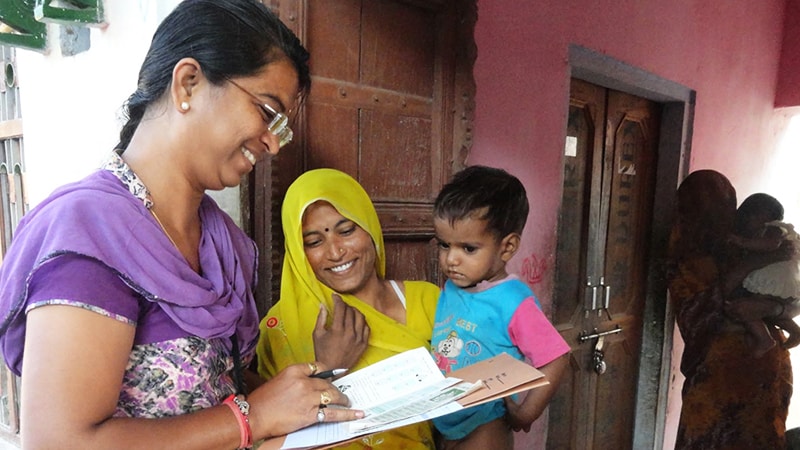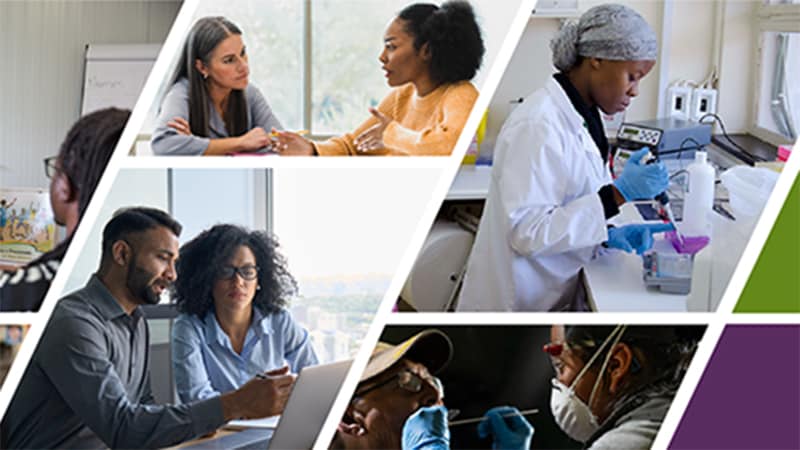At a glance
- CDC's commitment to health equity ensures that the elimination of health inequities is central to our work and transformational to our approach.
- Learn how health equity is embedded in our global work.

Overview
Health equity is embedded in CDC’s global work and is a fundamental core principle in CDC’s science and program strategy. Closely considering individual country and community contexts is critical for CDC’s health equity work, including efforts implemented through CDC’s country and regional offices in more than 60 countries.
Five pillars undergird and guide CDC's global public health work: scientific expertise, diverse partnerships, innovation, sustainability, and health equity. CDC works to eliminate health disparities and achieve optimum health through all these core principles and, more specifically, by focusing on initiatives and interventions that reach people in greatest need.
Vision
Everyone can achieve the highest attainable level of health. No one is disadvantaged from achieving this potential because of social position or any other socially, economically, demographically, or geographically defined circumstances or physical condition.
Strategic plan
Key definitions
There are numerous terms and definitions in health equity literature and communications. While consensus continues to evolve, CDC subject matter experts have drawn from a range of sources to define terms used in this strategy:
Health Equity - The state in which everyone has a fair and just opportunity to attain their highest level of health.
Health Disparity - A plausibly avoidable, systematic health difference adversely affecting a socially or economically disadvantaged group.
Health Inequity - A particular kind of health disparity that is reasonably believed to reflect injustice.
Health Equity Science - Science that investigates patterns and underlying contributors to health inequities and builds an evidence base that can guide action across the domains of public health program, surveillance, policy, communication, and scientific inquiry to move toward eliminating, rather than simply documenting, inequities.
Projects and initiatives
CDC supports a range of activities to address health inequities, including:
Programs
- The Girls Club is an initiative supported by the U.S. President's Emergency Plan for AIDS Relief (PEPFAR) through the DREAMS program. CDC often supports the community organizations that implement these programs. The Girls Club provides a space for young girls and women to meet weekly to talk about sexual and reproductive health, financial literacy, job readiness, and more.
- Tuberculosis (TB) is the leading cause of death for people living with HIV. Many populations of focus – including gay and bisexual men, people who inject drugs, female sex workers, and incarcerated people – cannot access timely TB testing and treatment due to stigma and discrimination. With support from PEPFAR, CDC tailors HIV and TB services and programs in Uganda and South Africa to meet the unique needs of these populations.
- Annual influenza epidemics disproportionately impact people living in tropical low- and middle-income countries (LMICs). To help reduce health inequities in LMICs, CDC collects data from a dozen countries to understand which factors increase people's risk of harmful effects of illnesses like influenza. CDC shares this information with local health authorities so they can use data-driven strategies to communicate risks of disease and encourage vaccination.
- Since 2006, two rotavirus vaccines (Rotarix and RotaTeq) were introduced in over 90 countries and have reduced death and disability related to rotavirus. Due to recent issues with limited supply, some countries switched to new rotavirus vaccines (Rotavac and Rotasiil). CDC and partners are studying these vaccines to ensure that they adequately and equitably prevent disease.
- CDC and WHO work with Ministries of Health in Africa to ensure that they can generate robust, high-quality data on the performance and safety of rotavirus vaccines. This information is important for sustaining the use of rotavirus vaccines and encouraging other countries to adopt the vaccine. Ultimately, when high-quality data show that public health tools are effective, decision-makers can better ensure that people have equitable access to rotavirus vaccines.
Partnerships and technical support
- CDC supports the Partnership for Influenza Vaccine Introduction (PIVI) to expand and sustain influenza vaccination in LMICs. Since 2012, PIVI has provided technical support and more than five million vaccines to 18 partner countries. PIVI's support helps inform policy decisions, like ensuring that partner countries can get vaccines within their country, instead of relying on donations. Programs and partnerships like PIVI are essential to preparing for future pandemics and proved useful in the planning, distribution, and evaluation of COVID-19 vaccines.
- CDC organized the global distribution of thousands of Influenza SARS-CoV-2 (Flu SC2) multiplex assays (test kits) to more than 160 laboratories in more than 140 countries. This equals more than 1.5 million tests that CDC helped distribute since October 1, 2020. These kits helped partners in LMICs conduct more tests in less time, which saves lives.
Actionable data
CDC defines health equity science as the investigation of underlying contributors that lead to health inequities and the use of data to inform programs, surveillance, policy, communication, and research. CDC strives to move toward eliminating, rather than simply documenting, inequities. CDC's Global Health Center (GHC) is measuring our progress in health equity science by tracking projects and publications. GHC will use this data to guide future scientific and programmatic priorities.
Internal trainings
CDC staff developed an introductory course to strengthen CDC employees' shared understanding and implementation of health equity concepts. The introductory course has been applied to fit the cultural contexts of CDC country and regional offices. After the training, offices develop concrete strategies to continue promoting health equity in their work.
Health equity science trainings help CDC staff develop programs that advance health equity by design, analyze disaggregate data, identify underlying contributors to health inequities, and seek to eliminate inequities. CDC uses this scientific review process to address health equity in global programs, surveillance, and research.
Internal discussion forums
- CDC staff organize journal clubs to foster discussion based on peer-reviewed journal articles related to global health equity. These journal clubs provide a safe space to learn from each other and exchange ideas.
- CDC also seeks to learn from partners and engage in interactive discussions through the Global Health Equity Speaker series. During these lectures, external guest speakers present to CDC staff and leadership and discuss health equity topics, including:
- Data, social determinants, and decision making.
- Lessons learned for future pandemic preparedness.
- Gender equity.
- Adaptive leadership principles to advance equity.
- Data, social determinants, and decision making.
Featured stories
CDC regularly publishes stories about our global impact. Many health equity program stories and updates are also featured in CDC's Global Health Center Annual Report.
Find more global health equity videos.

